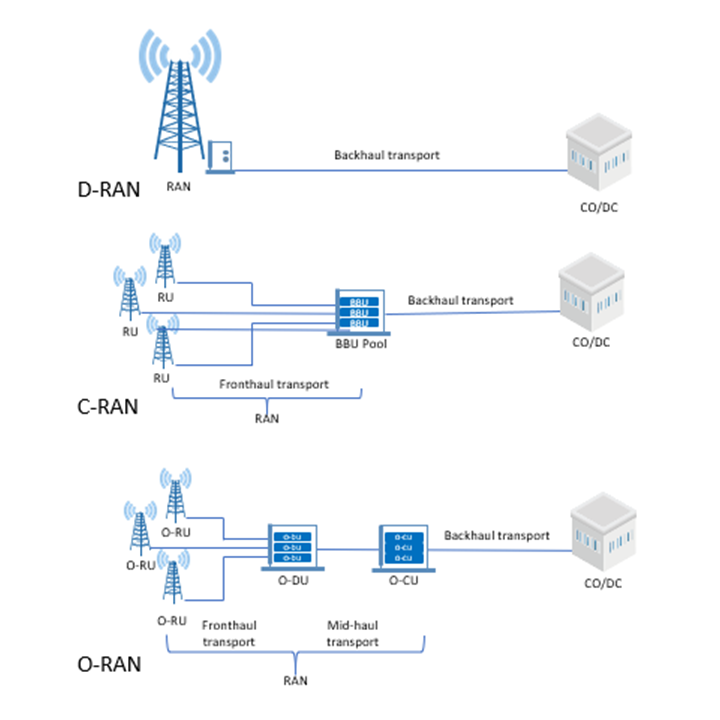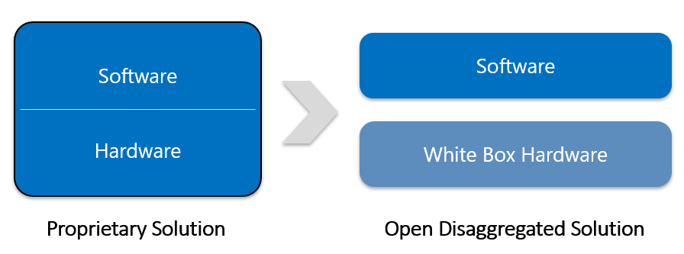Building Efficiencies into 5G Transport Networks

The telecom transport network is a part of the infrastructure that doesn’t get too much light. It’s not as exciting as the hulking radio towers as the RAN or the application-focused edge cloud. However, it’s just as important, if not more important, because it’s the responsibility of the transport network in telecom to carry the data to where it needs to go. So, an efficient transport network is needed to enable the services touted by 5G.
What is the transport network?
In order to make something more efficient, we first need to understand what we are working with. The transport network makes up the infrastructure that carries data from the access through the metro aggregation to the core. It used to consist of the backhaul and core transport, however, the introduction of 5G also introduced a more prominent role of the transport network within the RAN.
Transport network in the RAN
In a traditional D-RAN architecture, the transport network has a minimal role since the base band unit is installed in close proximity to the radio units. However, the potential to shift from a D-RAN to C-RAN introduced the fronthaul transport network. In the C-RAN, the radio unit (RU) and the base band unit (BBU) are split farther apart to improve resource utilization and deployment flexibility. The fronthaul transport network would aggregate the data from RUs and transport it over a certain distance to a central office where the BBU pool is located for processing.
The 5G RAN takes it a step further by introducing a logical split with the BBU into a distributed unit (DU) and centralized unit (CU). This split architecture brings more flexibility and allows for coordination of features to accommodate various 5G use cases. In a scenario where the three components (RU, DU, and CU) are physically split apart. The fronthaul would carry data between the RU and DU, while the mid-haul would transport data between the DU and CU. This type of architecture is being utilized in O-RAN (open RAN) designs.

D-RAN vs C-RAN vs O-RAN
Introducing the fronthaul and mid-haul will bring some challenges for the transport network. 5G services is expected to need higher bandwidths and have more stringent timing requirements. This means that the transport equipment has to have the right features to meet these requirements.
The backhaul and core transport networks
Other than the fronthaul and mid-haul, the 5G transport network also consists of the backhaul and the core transport networks. The backhaul transport is the infrastructure that aggregates access traffic (such as that from the RAN) and transports that traffic using various technologies (Ethernet, microwave, optical fiber, etc.) to the central office or data center.
The core network is the backbone of the service provider’s network interconnecting regional and sometimes national nodes and offices. At the edge of the core network is where a service provider’s networks handle data that is entering or leaving from other service providers or customers. Typical core networks will have two types of switching equipment called the P router and the PE router, each with its own functions and feature requirements.
The transition to 5G means that the fronthaul, mid-haul, backhaul, and core transport networks are also going through a transformation and with open networking, the whole 5G transport network can be made even more efficient.
An Efficient Transport Network Architecture
A transport network built with proprietary solutions will have their own operating system, functions and controller locked within their own equipment. This usually limits the service provider because they are only able to select solutions from one vendor. Using solutions from others will depend on that vendor’s willingness to integrate, and if they are willing, often times it has long development times or higher integration costs.

By introducing open disaggregated solutions into the 5G transport network, service providers can address these challenges by taking advantage of an ecosystem of vendors building solutions on white box platforms. Separating the software and hardware also allows for the each to be developed separately. Not only will service providers have more choices for solutions, they can choose the best-of-breed solution for both hardware and software to implement into their network.
White box platforms utilize bare metal switches built with merchant silicon, both of which are made widely available to be purchased for development. This allows for more economy of scale and enables white box platforms to be more cost efficient than proprietary platforms.
Disaggregation can be taken a step further to provide even more efficiencies by further separating the software to make it easier to develop, manage and deploy. By disaggregating the software into separate layers and incorporating open network interfaces, the service provider can easily adopt services from the solution provider of their choice.

Multi-functioning Disaggregated Solutions
5G transport network equipment are located in various positions throughout the network (fronthaul, mid-haul, backhaul, and core). Each of these positions will usually need different feature sets to fulfill. For example, fronthaul will have more stringent timing requirements than backhaul and a provider edge will require more computing capabilities. These feature sets may require multiple equipment models to fulfill, which can complicate deployment, inventory managment and maintenance. However, a multi-functioning white box platform coupled with the right software features can be deployed throughout the transport network. This can introduce further efficiencies such as simplified inventory management and more streamlined maintenance services.
The UfiSpace S9600 series of open aggregation routers can provide an efficient, multi-function solution that can be positioned throughout the transport network. The white box platforms provide multiple timing interfaces (GNSS, ToD, 1PPS, and 10MHz) with for support IEEE 1588v2/PTP and SyncE standards to enable timing synchronization in both legacy and 5G backhaul transport. Additionally, the S9600-72XC has a TCAM option for additional performance in broadband network gateway and peering applications.
With support for Time Sensitive Networking (TSN), the S9600-32X, S9600-64X and the S9600-72XC can all be used as part of the fronthaul transport network to aggregate data. As service providers transform their RAN into 5G-RAN architectures, fronthaul aggregation would be a critical part of the C-RAN and O-RAN hubs.
Related content: Open Multi-Service Aggregation at the Edge
IPInfusion’s OcNOS introduces a host of features when implemented with the S9600 routers such as L2/L3 transport services and the implementation of a grandmaster clocks throughout the transport network enabling time critical services with Class C accuracy. It enables the S9600 platforms can be used in multiple positions throughout the 5G transport network.
Deploying Multi-vendor Solutions
For those wondering about the complexities of managing a solution with multiple vendors, IPI FAST is another way to make things more efficient. UfiSpace and IP Infusion have created synergies throughout the purchasing process from solution design to logistics to maintenance services.
For more information or to get samples of UfiSpace’s 5G transport network solutions, please contact our sales team.
